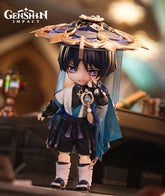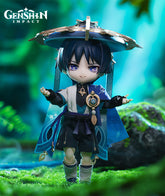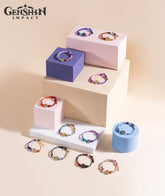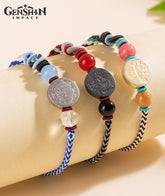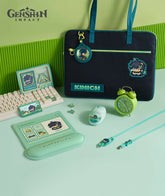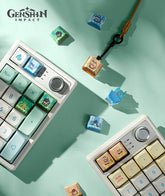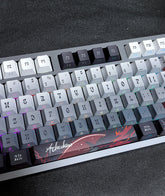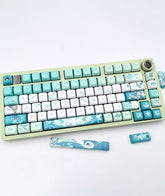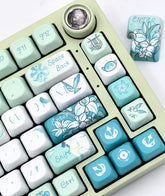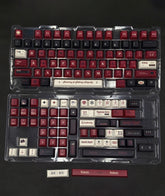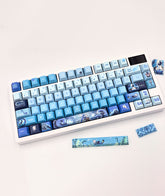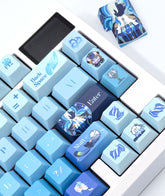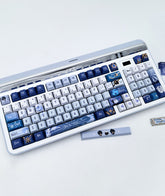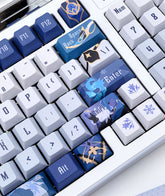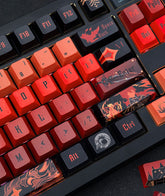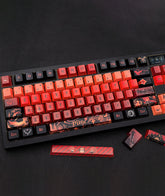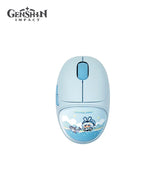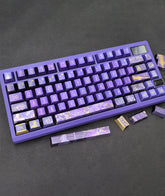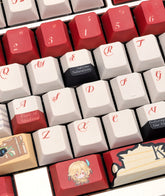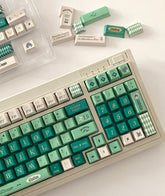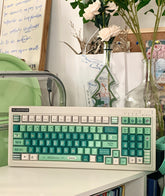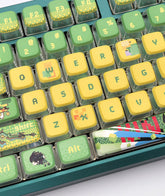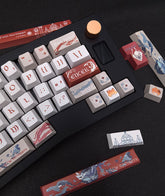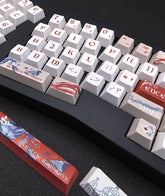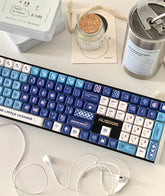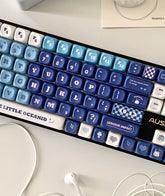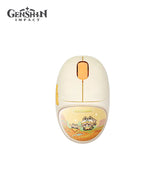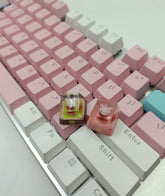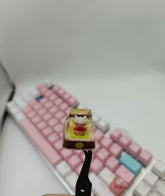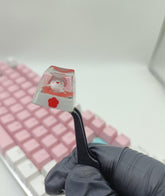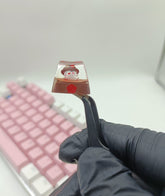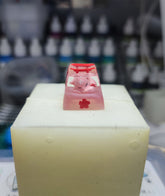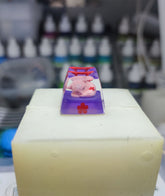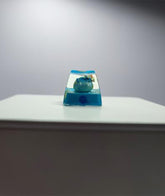The Most Comprehensive Genshin Impact Keycaps Buying Guide
I believe that travelers traversing back and forth across Teyvat must rely on comfortable and high-quality peripheral devices, especially for Genshin Impact PC players. Among peripherals, the keycaps we're highlighting today not only remain rarely recommended, but many third-party Travelers and official Genshin Impact Team have consistently released premium crossover keycaps with different materials that offer comfortable tactile feedback.
Now let's quickly follow these steps to discover how to choose your perfect keycaps!
1. Understand the Compatibility of Your Keyboard Keycaps
1.1 Can your keyboard keycaps be replaced with Genshin-themed ones?
First, let's discuss compatibility. Many players' first question when buying keycaps is: "Can my keyboard use Genshin-themed keycaps?" This question is actually easy to answer. Remove a keycap and check if your keyboard switch has a cross-shaped stem. If yes, congratulations-your keyboard is compatible.

Most mechanical keyboards on the market use this cross-shaped stem design, making them safe for keycap replacement. However, some keyboards with unique stem shapes cannot be modified. Additionally, keyboards with special layouts may have keys of non-standard lengths, leaving few compatible keycaps available.
1.2 Keycap tactile feel (comfort level)
After confirming whether your keyboard allows keycap replacement, the next step is selection. The inevitable question arises: "How to choose based on keycap surface feel?" This depends on your preference between sandblasted or smooth finishes. Most manufacturers currently prioritize smooth surfaces. While sandblasted textures may feel less comfortable, they offer greater durability and resistance to wear.
Keycap surface treatments typically involve sandblasting or texturing on injection molds. Alternatively, spark erosion creates textures on molds, producing keycaps with varied tactile surfaces. However, the precise texture, tactile feedback, and comfort level vary between manufacturers, making it difficult to assess through product listings. The most reliable approach is to patiently inquire with sellers or search for reviews containing specific tactile descriptions.
1.3 What is a "Full Set of Keycaps", and what are "Supplemental Keycaps"?
This section specifically addresses non-standard keyboard layouts. Standard keycaps can fit 87-key and 104-key keyboards without issues. Only keyboards with unique layouts require supplemental keycaps due to differences in keycap lengths. Let's briefly examine how keycap lengths are categorized.

Take a 104-key keyboard: The most common alphanumeric keys are 1U in length. The Tab key uses 1.5U; Caps Lock is 1.75U; Left Shift and Enter measure 2.25U; Right Shift spans 2.75U; Backspace and numpad 0 keys are 2U; bottom-row Ctrl/Fn keys use 1.25U; the Spacebar extends to 6.25U.

So what defines a "non-standard layout"? Let's examine the FL980 keyboard as an example: The three keys on its lower-right corner use 1U length instead of standard 1.25U, and the right Shift key measures 1.75U instead of 2.75U. When purchasing keycaps for such keyboards, you'll need "full sets with supplemental keys".
However, manufacturers interpret "full sets" differently. Some exclude 2U Shift keys, so thorough research before purchase is strongly recommended.
1.4 What are the differences in height profiles between keycap types?
In addition to keycap length, height requires careful consideration during purchase. Height has dual meanings: one refers to profile types like Cherry profile or OEM profile (to be discussed later); the other denotes ergonomic row-specific heights categorized as R1, R2, R3, and R4. Using the common Cherry profile as an example, starting from the bottom row: rows 1-2 are R1, row 3 is R2, row 4 is R3, and rows 5-6 are R4.

Now let's explore how height rankings differ across various keycap profile types!
2. Discussion of common keycap height profiles (keycap types)
Keycap height profiles significantly impact keyboard tactile feel and acoustics. Selecting an appropriate profile enhances comfort during use. This guide focuses on commonly available types, excluding obscure profiles that are hard to acquire and manufacturer-exclusive designs.
2.1 Cherry Profile
First introduced is the Cherry profile, which originally referred to Cherry's design. Now synonymous with this type, it remains the most prevalent keycap height in the market. This profile offers superior comfort, though slight variations exist between manufacturers' mold specifications-some caps being thinner or thicker-but overall dimensions remain consistent with no significant deviations.

Notably, Cherry profile's inherent low height combined with thick inner walls may cause interference with "inverted switches". During installation, keycaps might contact the switch top housing, resulting in altered tactile feedback and acoustics. Therefore, if your keyboard uses inverted switch orientation, exercise caution when purchasing Cherry profile keycaps.
2.2 OEM Profile
Next is the OEM profile, which resembles Cherry profile but with greater overall height. Initially popularized by Filco keyboards, this remains the most prevalent height on mass-produced keyboards. Its primary advantage is avoiding switch interference common with Cherry profile.

The drawback lies in its taller structure creating larger internal cavities, amplifying typing noise compared to other profiles. However, this enhanced acoustics provide stronger feedback for gamers.
Regarding OEM profile keycaps, the newly released Fan-made Alhaitham Keycap Set deserve mention. Standing out among Genshin keycaps, the vibrant color scheme and unique font design perfectly embody Alhaitham's characteristics. The white-and-green colorway maintains timeless visual appeal.
2.3 XDA Profile

This profile was originally designed by a Chinese custom keyboard enthusiast with an appearance patent. However, most keycap manufacturers disregard patent concerns, making XDA profile clones ubiquitous in the market. Numerous products now claim "XDA-like" designs.
The XDA profile stands out with its unique characteristics. All keycaps share identical height without R1/R2 row differentiation, maintaining complete flatness. This curvature-free design may cause initial typing discomfort and prone to errors. However, its flat surface makes it ideal for themed keyboards, as graphics appear flatter and more aligned, delivering superior visual cohesion and allowing flexible keycap rearrangement.
2.4 SA Profile

Keycaps in this profile remain relatively uncommon and pricier, primarily circulating among seasoned enthusiasts. Signature Plastics (SP) dominates production, with Maxkey and others following suit. Recent iterations like AKKO's ASA (Angled Spherical Architecture), OSA (Oblique Spherical Architecture), and FSA (Flat Spherical Architecture) claim SA profile modifications, though significantly deviating from the original design.
While SA profile keycaps deliver visually striking aesthetics and pleasant acoustic feedback, their ergonomic practicality falters. The excessive height strains wrists, often necessitating wrist rest accompaniment for comfortable usage.
3. Material differences between keyboard keycaps
Having covered height profiles, let's now discuss keycap materials. The material landscape is straightforward: ABS and PBT dominate the market, while POM requires minimal explanation due to its extreme rarity.
Price-wise, ABS spans all market tiers (premium to budget) with significant cost variations, whereas PBT primarily occupies the mid-to-low price segment.
3.1 ABS keycaps (Acrylonitrile Butadiene Styrene)
Starting with ABS material: As one of the five major synthetic resins, ABS boasts advantages like excellent toughness, smooth tactile feel, vibrant colors, and high saturation. This translates to silky-smooth finger contact during use, comfortable operation, and visually striking aesthetics. Drawbacks include low heat resistance and susceptibility to greasing. Never use hair dryers when cleaning these keycaps. The material's poor abrasion resistance also causes prolonged-use keycaps to develop an oily reflective sheen.

3.2 PBT keycaps (Polybutylene Terephthalate)
Next is PBT material, classified among the five major engineering plastics. PBT's advantages include heat resistance, abrasion resistance, and rigidity. Its exceptional wear resistance makes PBT keycaps a mainstream choice for gamers. The heat tolerance also enables vibrant pattern printing through sublimation techniques.

The drawbacks involve comparatively rougher texture and less vivid colors than ABS. However, manufacturers now produce PBT keycaps with refined surfaces, while some ABS versions adopt sandblasted textures. Ultimately, surface treatment determines quality. Well-crafted PBT keycaps rival ABS in tactile feel, though color vibrancy remains slightly inferior.
The newly released Fan-made Xiao Keycap Sets exemplify this. The Genshin Xiao Keycap Set demonstrate superb surface treatment, with character-specific font designs that captivate visually. The color scheme mirrors Xiao's in-game appearance, featuring intricate patterns on spacebars. Two interchangeable supplemental spacebars expand customization possibilities-essential for dedicated Xiao enthusiasts.

Among Genshin-themed keycaps, the PBT-based Fan-made Furina Keycaps stand out with innovative FOA profile. Slightly taller than Cherry profile, this height delivers enhanced keystroke confirmation and premium tactile feedback.

3.3 Resin, Metal, and other materials Keycaps
Beyond the two common materials, there are rare options like resin and metal. These materials are typically crafted into artisan keycaps with premium pricing-ranging from around $10 per keycap to hundreds of dollars. Such keycaps are best purchased sparingly as decorative accents.

4. Keycap Manufacturing Process Distinctions and their Impact on Usage
Finally, let's discuss manufacturing processes. Keycaps utilize various techniques: Historically common methods included laser etching, pad printing, soft-touch coating, dye-sublimation, and etching with color filling. Contemporary mainstream processes are double-shot molding, two-tone molding, and dye-sublimation.
4.1 Laser Etching keycaps
Laser-etched keycaps use lasers to engrave characters onto surfaces, creating tangible texture through physical grooves. This low-cost method was historically prevalent but has fallen out of favor, making such keycaps not recommended for purchase.
4.2 Pad-printed keycaps
Pad printing pales in comparison to laser etching. This process involves covering keycaps with specialized mesh screens containing character cutouts, then scraping ink across the surface to deposit pigment through the openings. However, such legends wear off easily-low-quality versions may even flake off when scraped with fingernails.

This technique remains prevalent on membrane keyboards. Higher-end pad-printed keycaps apply UV coating over legends to prolong durability, though eventual wear is inevitable. If purchasing pad-printed keycaps, prioritize side-printed versions where legends avoid direct finger contact and thus resist abrasion.
4.3 Soft-touch coated keycaps

This soft-touch coating process mirrors that used on mice-applying a layer to translucent keycaps while masking light-transmission areas for backlit patterns. Common on premium keyboards from major manufacturers, these keycaps offer excellent tactile feel but are prone to staining. Users with sweaty hands will notice visible fingerprints accumulating rapidly during use.
4.4 Dye-sublimated keycaps
This process involves boiling white PBT keycaps in pigmented water, where color saturation is controlled by pigment concentration and boiling duration. Such keycaps are particularly suitable for DIY customization.
4.5 Etched-and-filled keycaps
Combining laser etching with ink filling, this technique first laser-engraves characters then fills the grooves with ink, creating abrasion-resistant legends. It represents an enhanced version of laser etching and pad printing.
These processes are now largely obsolete and rarely encountered. Therefore, selecting keycaps utilizing these methods is not recommended.
4.6 Double-shot molded keycaps
This type currently represents the most prevalent keycaps on the market, available in legend-translucent and opaque variants sharing identical manufacturing process. The technique injects two colored plastics in a single molding cycle within injection machines. Legends come in open/closed design configurations.

Compared to the "two-shot molding" process we'll discuss next, this method features higher automation levels and lower costs. However, some units may exhibit uneven legends due to mold precision issues. For budget-conscious buyers, selecting PBT double-shot molded keycaps priced around 100 RMB offers cost-effective durability.
4.7 Two-shot molded keycaps
Following the double-shot process is the similar two-shot molding technique. Comparatively, two-shot molded keycaps carry higher costs due to their dual-stage production: initial molding on one injection machine, then transferring to another for secondary color injection, requiring two molding cycles. This complexity increases production expenses, making two-shot molding less scalable and ideal for small-batch custom projects.
Both double-shot and two-shot molding share critical advantages: their legends remain virtually wear-proof unless the keycap itself wears through. As injection-molded processes, their primary costs lie in mold development rather than material expenses-whether PBT or ABS, raw material costs are negligible.

This manufacturing process produces some of the most sought-after keycaps currently available. Most premium keycaps utilize this technique, delivering exceptional craftsmanship. However, these keycaps are primarily marketed for color schemes. Creating customized keycaps with unique designs requires dedicated mold fabrication, which exponentially increases production costs. Consequently, customized two-shot molded keycaps command premium prices. This category remains my top recommendation.
4.8 Dye-sublimation keycaps
So what if you prefer patterned keycaps? This is where the dye-sublimation process comes into play. The technique involves printing desired designs onto specialized thermal transfer paper or transfer film, then placing the material alongside blank PBT keycaps (the base) into a machine. Heat causes the ink to sublimate into gaseous state, permeating and re-solidifying within the keycap material.

These keycaps achieve enhanced durability through ink penetration into the material, exclusive to PBT (ABS cannot withstand the required heat). While less wear-resistant than two-shot molded keycaps, their patterns remain intact under normal use. Many original designers prioritize dye-sublimation precisely for its design fidelity-complex graphics reproduce flawlessly without requiring custom molds.
This category further divides into single-side and five-side sublimation. As the names suggest, the former prints on one surface while the latter covers all five sides. Five-side sublimation incurs higher difficulty, defect rates, and costs. Mastering this technique demands extensive practice with transfer film consumption. Consequently, discounted dye-sublimation sets often comprise practice-run rejects.

Since dye-sublimation keycaps often source base materials directly from injection factories, material batch variations occur. These differences in base materials create "old/new batch" distinctions affecting tactile feel-some newer batches even deliver inferior tactility compared to older ones.
The process has other limitations: Due to heating requirements, elongated keys like spacebars tend to warp during processing. Color deviations, ink bleeding, and pattern resolution inconsistencies are common. Crucially, light transmission remains problematic-backlit keycaps resemble glowing lanterns, compromising aesthetics. Manufacturers often add light-blocking additives to PBT, but excessive amounts embrittle keycaps (risk of cracking during installation) and dull sublimated colors. Opting for manufacturers with mature processes helps mitigate these issues.
This concludes the majority of keycap knowledge we've covered. Have you grasped these concepts? Of course, beyond high-quality Fan-made keycaps, Genshin Impact's official team also frequently collaborates with established manufacturers to release character-themed keycaps that set industry-leading standards in both quality and aesthetics.
If you're seeking premium keycaps to decorate your keyboard, these offerings deserve your attention. Stay tuned—we'll soon launch more technical articles and official merchandise. Be sure not to miss out!












